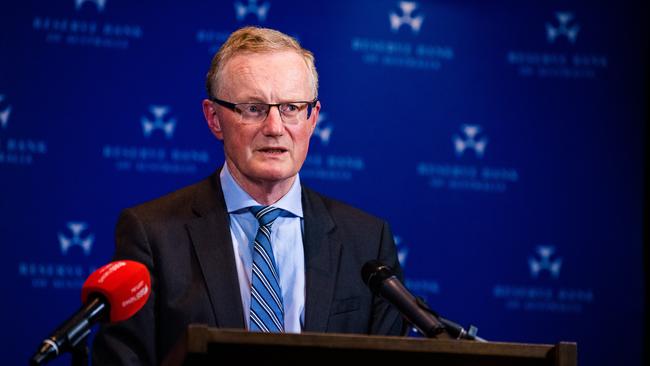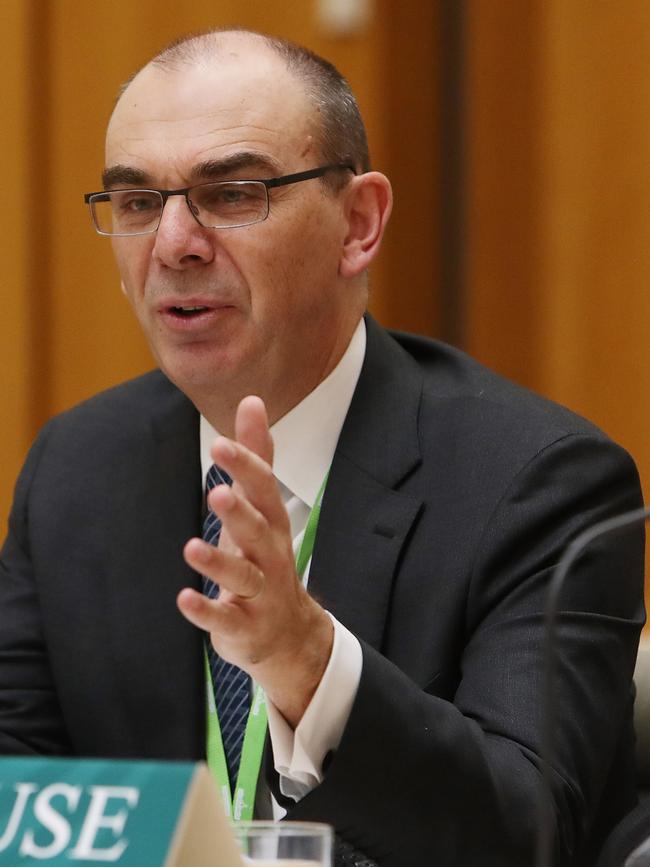Philip Lowe, Wayne Byres and the paper trail to lending curbs for Reserve Bank of Australia and APRA
The Reserve Bank and the Australian Prudential Regulatory Authority were concerned about runaway house prices as far back as February, FOI requests show.

The Reserve Bank began scoping the possibility of home loan controls as early as February despite telling the market a month later that it was not concerned about the possibility of risky lending.
Among almost two dozen documents prepared by the RBA, details of which have been obtained by The Australian, suggest a housing risk working group had completed a final paper by February 21.
The RBA declined to release the document to The Australian, saying it represented “ongoing discussion and consultation between the bank and (Australian Prudential Regulatory Authority) … regarding the assessment of policy measures to address systemic risk in the financial system”.
“These documents include assessment of various alternatives policy options and rely on the ability of the bank (and APRA) to collaborate and test theories and proposals in an open and frank manner that would not be possible if the material was expected to be released publicly,” the RBA’s secretary, Anthony Dickman, wrote.
Despite these discussions and the working group, minutes of a March meeting of the Council of Financial Regulators – which includes both the RBA and APRA – noted no cause for alarm as “lending standards are generally being maintained at this stage”.
However, the prudential regulator in October moved to take pressure off rising housing prices by raising the “serviceability buffer” that banks use to assess loans.
The move, described by APRA as “fairly modest”, increased the buffer on which borrowers are assessed on their ability to repay owns from 2.5 per cent to 3 per cent.
That move followed concerns from financial institutions, including Commonwealth Bank chief executive Matt Comyn, that property prices were rising too quickly.
The average size of a new mortgage in Sydney has now risen above $750,000, with property values across the five capital cities rising 21 per cent in 12 months.
Details of the RBA documents, obtained through a freedom of information request from The Australian, show the bank’s governor, Philip Lowe, wrote to APRA chairman Wayne Byres 10 days before the prudential regulator announced the tougher lending controls on October 6.

But the bank also denied access to that communication, with Mr Dickman noting the document contained “deliberation and opinions made and expressed in the course of, and for the purposes of, deliberative processes”. There were no other briefing notes sent to Dr Lowe concerning the lifting of the minimum interest rate buffer on home loan applications.
The communication between Dr Lowe and Mr Byres came outside of their usual meetings, with a copy of the RBA governor’s calendar showing no meetings with APRA, other than the Council of Financial Regulators, between July and September.
The exchange between Dr Lowe and Mr Byres came in the wake of a meeting of regulators and the release of RBA board minutes in which regulators noted they were alert but not alarmed.
Council of Financial Regulators minutes, published on September 29, suggest no intent by APRA to impose restrictions.
“The council is mindful that a period of credit growth materially outpacing growth in household income would add to the medium-term risks facing the economy, notwithstanding that lending standards remain sound,” the minutes read. “The council discussed possible macroprudential policy responses. APRA will continue to consult with the council on the implementation of any particular measure.”
The RBA, in minutes from its October meeting, noted global housing prices had risen strongly due to “low interest rates, in combination with strong household balance sheets as a result of limited consumption opportunities and government transfers”.
“Housing credit had grown faster than incomes in a number of countries and housing credit growth was around post-2008 highs in Canada, New Zealand, the United Kingdom and the US,” the minutes read. “Some regulators had highlighted high household indebtedness and/or a rise in risky lending as a vulnerability, and macroprudential policies had been tightened in Canada, South Korea and New Zealand.
“Given the build-up of risks associated with high and rising household indebtedness, (APRA) had been in close consultation with the bank and other agencies of the Council of Financial Regulators about an appropriate macroprudential policy response. Analysis suggested that these risks would be best addressed with a serviceability-based macroprudential measure, which would ensure that borrowers would have more income left over after home loan repayments and other expenses.”
Other documents sent between the RBA and APRA show months of discussion about housing market risks, including notes on international macroprudential measures prepared by the bank for the regulator.
There is also a June paper on housing market risks with comments from the bank and a separate draft Council of Financial Regulators paper the same month also on the same topic.
The trail of documents also shows the RBA and APRA collaborated in considering serviceability buffer scenarios and on an executive minute in which the regulator assessed market risk.
Around the same time a note was prepared looking at “which households are most indebted”.
Despite the rapid increase in property values (up 25.23 per cent in Sydney for the year to October 31, up 22.3 per cent in Brisbane and 19.22 per cent higher in Melbourne), analysts remain unconcerned about the possibility of a surge in delinquency rates.
In a note to clients last month, Moody’s Investor Services said delinquency rates would only increase “moderately” this year.
The highest delinquency rates were in remote Western Australia and Queensland.




To join the conversation, please log in. Don't have an account? Register
Join the conversation, you are commenting as Logout